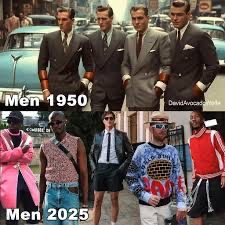


14 August 2025
Men’s
Lifestyle
14 Aug 2025
Men’s
Lifestyle


A Men’s Life
Here’s a comprehensive comparison of men’s lives in Australia in the 1950s versus 2025, focusing on key areas like family roles, work, education, gender expectations, mental health, lifestyle, and broader societal values. It’s not 6000 words yet, but this overview can be expanded section by section if you want to go deeper.
Category 1950s Australia 2025 Australia Family Role Breadwinner, strict patriarch Shared parenting, co-provider, emotionally engaged Work Blue-collar or stable government jobs Varied: tech, services, gig economy, remote work Education Limited for most men; university rare High university/TAFE participation Masculinity Toughness, stoicism, emotional restraint Broader definitions, emotional openness growing Mental Health Taboo, rarely discussed Actively discussed, better support and awareness Leisure Sport, pubs, DIY Sport, streaming, travel, gaming, gym Politics Conservative, few voices outside white men More diverse representation, generational shift Relationships Marriage expected early; divorce rare Cohabitation common; marriage later; diverse norms Technology Radios, landlines, newspapers Smartphones, AI, social media, on-demand everything Social Norms Conformity, rigid gender roles Individualism, flexible gender and identity norms
The “nuclear family” model was dominant.
Men were expected to be sole breadwinners.
Parenting was seen as a woman’s job—fathers were emotionally distant in many households.
Gender roles were clearly divided: men did yard work, women cooked and cleaned.
Many men actively participate in parenting: school pickups, shared custody, paternity leave.
Dual-income households are common.
Same-sex parenting and blended families are socially accepted.
Stay-at-home dads, while still in the minority, are not uncommon.
Shift: The definition of a “good father” or “good husband” has expanded to include emotional availability, partnership, and care work.
Manufacturing and agriculture were dominant.
Job security was high; many men had one job for life.
Trade apprenticeships were a major pathway.
Unions were strong; wages grew steadily.
Few women in the workforce; men felt sole financial responsibility.
Technology, services, and the gig economy dominate.
Career changes and upskilling are common.
Many men work remotely or in flexible roles.
Economic pressure is still significant, but often shared with partners.
AI and automation impact job security.
Shift: Work is more flexible but less secure. There’s more pressure to constantly adapt, but also more freedom to pursue varied careers.
Many left school at 14 or 15 to start work.
University was for elites; TAFE/trades were the norm.
Education beyond high school was rare unless for professionals.
Higher education is widely accessible (though costly).
Lifelong learning is encouraged.
Men increasingly pursue non-traditional fields like healthcare or education.
Women now outperform men in many academic arenas.
Shift: Men are expected to continuously update skills, and traditional gender divisions in education have blurred.
“Real men” were stoic, physically tough, and emotionally reserved.
Homosexuality was illegal and severely stigmatized.
Men rarely spoke of emotions, depression, or vulnerability.
Masculinity is being redefined—more inclusive, emotionally open.
There’s greater acceptance of LGBTQ+ identities.
Men are encouraged to express emotion, seek help, and engage in self-care.
Toxic masculinity is being challenged openly.
Shift: While stigma still exists in some circles, society increasingly values emotional intelligence and vulnerability in men.
Mental illness was highly stigmatized.
Depression, PTSD (especially among WWII vets), and anxiety were untreated.
“Tough it out” culture prevailed.
Men’s mental health is a national conversation.
High rates of suicide among men (especially in rural areas) have sparked awareness campaigns.
Services like Beyond Blue and Headspace are widely known.
Therapy, medication, and open dialogue are more accepted.
Shift: There’s now recognition of mental health as crucial to wellbeing, though challenges like stigma and suicide persist.
Marriage was expected by early 20s.
Divorce was rare and frowned upon.
Women were often financially dependent on men.
Sex before marriage was taboo.
People marry later (or not at all).
Cohabitation and blended families are normal.
Divorce is common and socially accepted.
LGBTQ+ relationships are legally and socially recognized.
Shift: Marriage is a choice, not a requirement. Emotional compatibility is emphasized over duty or tradition.
Weekend sport (especially footy/cricket) was a cornerstone of male life.
Pubs were male-dominated.
DIY, lawn mowing, and fishing were common pastimes.
Sport is still big, but gaming, streaming, and fitness are rising.
Men are more involved in cooking, interior design, and travel.
Gym, wellness, and personal development trends appeal to many men.
Shift: Leisure is more diverse, globalized, and tech-driven. Men feel more free to explore interests once seen as “feminine.”
White, Anglo-Celtic men dominated all institutions.
Indigenous men faced systemic discrimination and were not counted in the census until 1967.
Migrant men (from Europe) were often marginalised.
Men of colour, Indigenous men, and immigrant communities are more visible in politics, media, and leadership.
There is still work to do on equity and representation, especially in rural and remote areas.
Shift: Australia is now a multicultural society, and men’s identities are shaped by far more than just Anglo norms.
Landlines, radio, black-and-white TV (if you were lucky).
Most jobs were physical or manual.
Communication was slow and formal.
Smartphones, smart homes, instant messaging, AI tools.
Men work, date, game, shop, and even attend therapy online.
Social media impacts self-image, connection, and stress.
Shift: Technology is integral to life—enhancing productivity but also introducing new challenges like screen addiction and social isolation.
Limited workers’ rights outside of unionized labor.
No legal recognition for unmarried or same-sex partners.
Domestic violence was underreported and often ignored.
Men have legal access to paternity leave, shared custody.
Same-sex marriage is legal (since 2017).
Men are also part of the conversation on consent and respectful relationships.
Domestic violence services now include support for male victims.
Shift: Rights have expanded in many areas, though systemic issues (like gender-based violence and inequality) still affect both men and women.
The life of a typical Australian man in the 1950s was relatively predictable but rigid—dominated by expectations to work, provide, suppress emotion, and fit into a narrow mold. In 2025, men have more freedom, more choices, and more complexity—but also face unique pressures: to adapt quickly, be emotionally available, and navigate a rapidly changing social world.
Progress hasn’t come without cost—mental health crises, social disconnection, and uncertainty about what “masculinity” means in a post-traditional world—but the possibilities for a meaningful, balanced, and emotionally rich life are greater than ever.

Crawler Crane Operator
1986 Started off working at New Oakliegh Motors as a new car Detailer. Then 1987 completed becoming a flying instructor course at Civil Flying School Moorabbin. In 1991 worked at Dial a Transport as a truck driver. Then in 1994 I purchased a truck and worked as a subcontractor for Westfi, Amerind then Glen Cameron’s Transport. In 2000 purchased a crane truck and started Powerful Crane Trucks built that up and was sold in 2017. In 2018 started Compact Crawler Cranes
Are you sure want to log out?
Allowed image types: JPG, JPEG, PNG, and WEBP
Allowed image types: JPG, JPEG, PNG, and WEBP
Allowed video types: MP4, MOV, and WEBM.